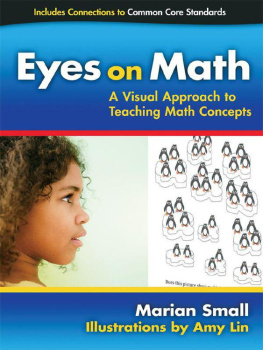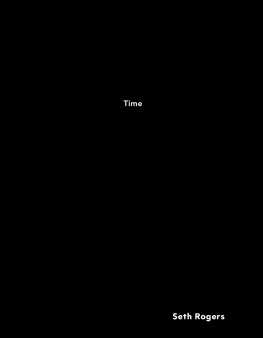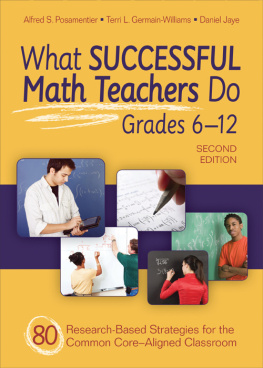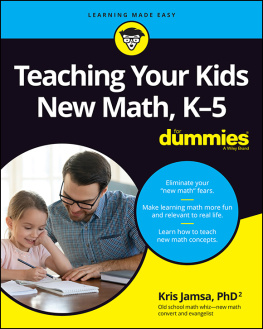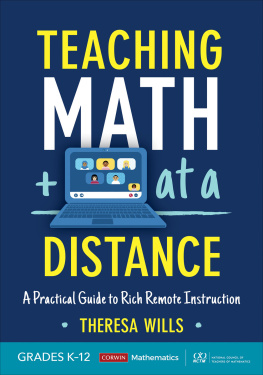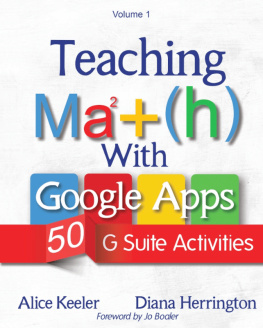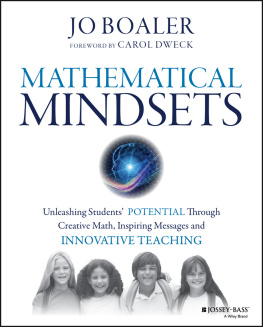Eyes on Math
A Visual Approach to Teaching Math Concepts
MARIAN SMALL
Illustrations by Amy Lin

Teachers College
Columbia University
New York and London

| 
|
1906 Association Drive, Reston, VA 20191
www.nctm.org | www.nelson.com |
Published simultaneously by Teachers College Press, 1234 Amsterdam Avenue, New York, NY 10027, and National Council of Teachers of Mathematics, 1906 Association Drive, Reston, VA 20191; distributed in Canada by Nelson Education, 1120 Birchmount Road, Toronto, ON, Canada M1K 5G4.
Published by Teachers College Press, 1234 Amsterdam Avenue, New York, NY 10027
Copyright 2013 by Teachers College, Columbia University
All rights reserved. No part of this publication may be reproduced or transmitted in any form or by any means, electronic or mechanical, including photocopy, or any information storage and retrieval system, without permission from the publisher.
Library of Congress Cataloging-in-Publication Data
Small, Marian.
Eyes on math: a visual approach to teaching math concepts / Marian Small; illustrations by Amy Lin.
pages cm
Includes bibliographical references and index.
ISBN: 978-0-8077-5391-0 (paper: acid-free paper)
1. MathematicsStudy and teachingAudio-visual aids. 2. Pictures in education. I. Lin, Amy. II. Title.
QA18.S63 2012
510.71dc23
2012030002
ISBN: 978-0-8077-5391-0 (paper)
NCTM Stock Number: 14573
e-ISBN: 978-0-8077-7236-2
Contents
Preface
A COLLEAGUE who works in the area of high school mathematics pointed out how well her students responded to the presentation of a simple picture that evoked mathematical thinkingno textbook or complicated activity was necessary. This got us thinking about the potential for a resource that focused on presentation of important mathematical ideas through pictures at all levels, not just for secondary grades.
ORGANIZATION OF THE BOOK
provides an introduction that addresses some of the research on the value of visual representations of mathematical ideas. It also discusses the importance of questioning that evokes a deeper understanding of mathematical concepts.
provide visuals and questions for discussion of selected mathematical topics in grades K2, 35, and 68, respectively. The intention is to help the teacher build a rich mathematical environment by using carefully constructed visuals to stimulate student thinking about mathematical concepts. Although, in certain instances, the visuals may seem similar to what educators have seen elsewhere, coupling the images with the carefully constructed questions that are provided is likely to be much more useful in developing robust understanding of the essential ideas underlying the concept the picture embodies than using either approach in isolation.
The online component of the book provides vibrant color pictures that can form the basis of valuable mathematical conversations. These can be downloaded (as either PDF or JPEG files) and projected onto a classroom smart board or screen. The printed book provides teachers with support for these conversations by
- Clarifying the main idea that the visual is intended to bring out and specifying where that concept appears in the Common Core State Standards for mathematics. The Appendix provides a convenient listing of topics sorted by standard.
- Explaining why the idea is an important one to develop in a mathematics classroom
- Explaining how the particular mathematical idea relates to other mathematical learning
- Specifically explaining why the provided visual is likely to evoke the idea
- Providing a series of additional questions to use in a conversation with students about the picture and the underlying mathematical idea(s), along with an explanation for teachers about how each question develops a particular key understanding
- Providing extensions. These extensions challenge students to create a drawing, use manipulatives, or otherwise create a new and related example. The extensions can be used to help students reinforce the new learning, to help teachers assess understanding, or both.
USING THIS BOOK WITH OTHER RESOURCES
Most teachers will find that the activities in this book nicely supplement whatever textbook or other materials they currently use. Teachers might use the Appendix or table of contents to explore useful visuals based on the topic being taught. Many of the visuals and associated questions provided in this resource would make excellent introductory activities; others would make excellent consolidation activities. It is usually clear from the question on the visual or from the associated textual material whether the activity is more suitable before or after other instruction. In addition, the supporting material will help many teachers to decide where to focus their questioning on a concept and to recognize some of the important ideas they need to bring out.
USING THIS BOOK TO DIFFERENTIATE INSTRUCTION AND CONNECT GRADE TO GRADE
The nature of the activities provided will assist teachers attempting to differentiate instruction. The questions are often open enough to allow for rich conversations, whether students are struggling or are advanced. A number of the questions are suitable for different grade levels; the responses most likely will get more sophisticated as students move through the grades. Teachers will be able to see how to connect the mathematics in the grade they are teaching to content in lower and higher grades.
CREATING YOUR OWN VISUALS
The visuals and questions provided in this book may motivate you to create visuals and questions on your own. You can start with a mathematical concept you wish students to explore and then consider the important aspects of that concept that can be illustrated or suggested in a visual and explored further through questioning and class discussion.
For example, consider the notion that multiplying a number by 2 is the same as adding it to itself. Associated concepts that could be brought out include what multiplication means, what addition means, and the fact that the principle holds no matter what the number is that is being considered. The discussion could begin with a picture that shows 2 identical groups of 6 objects, 2 identical groups of 10 objects, and 2 identical bags that clearly hold a large, but unknown, number of small objects. The main question might be: Do these pictures show addition or multiplication? Supplementary questions could focus on what makes one say something shows multiplication or addition, and why it is not necessary to know how many objects are in the bags (assuming the bags are identical) in order to know whether the picture shows multiplication or addition.
Acknowledgments
FROM MARIAN SMALL
Without Amy Lins amazing creative talent, this book could not have come to life. Her visuals make the book work.
I would also like to thank Jean Ward, our acquisitions editor at Teachers College Press, who was so understanding about our timelines and who has shown so much faith in our ability to produce something valuable for teachers and students.

